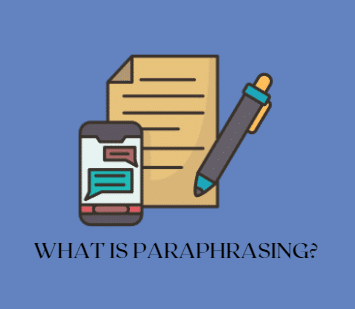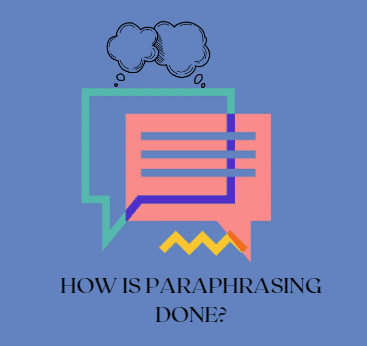While writing something, you, sometimes, have to put in some piece of writing that is written by somebody else. But you cannot do it directly, of course, because that’s not an appropriate way to borrow ideas.
Sure, you can quote the text but quoting is not practical to do every time.
What you do instead is, write that piece of writing in your own words so that it does not look copied. This is called paraphrasing.
We use paraphrasing all the time, both intentionally and unintentionally.
For example, you narrate a story to your friends that your father used to tell you when you were a kid. You don’t tell the exact words. You just try to keep the core idea the same and explain it in your own words.
We deliberately paraphrase the content when it comes to writing our academic essays, research papers, dissertations, assignments, etc. Because in academic writing, there is always a need of borrowing ideas from already published content.
In this article, we will find out what is paraphrasing, how it is done, and its uses in academic writing.
What is Paraphrasing?
Paraphrasing means rewording existing content in your own words while keeping the essence of the idea unchanged.

In the rephrasing process, the words and phrases are swapped with suitable substitutions that have the same meaning.
Keeping the sense of the main idea unchanged in the content is the basic goal of paraphrasing.
Rephrasing the content is done to avoid plagiarism. When you rephrase your content, you change its wording and structure to avoid the possibility of it being matched with the original sources.
Besides avoiding plagiarism, paraphrasing is done to make your content look more readable. That is because, during the paraphrasing process, simpler words and phrases can be used in the writing to make it more readable. After having an idea of what paraphrasing is, let’s focus on how it is performed.
Also read, Top 7 SEO Writing Tools to Drive More Google Traffic
How Paraphrasing is Done?
Paraphrasing content can both be easy and difficult.

Keeping the definition of paraphrasing, which is simplification and restructuring of the writing, in mind, paraphrasing can be done by performing the following steps:
- You can paraphrase your content by replacing main words with suitable synonyms. This will change the writing but keep its meaning the same.
- You can slightly change the structure and wording of the original content to make it look unique.
- Interchanging the active and passive voice sentences is an effective way to paraphrase. This will make your content new and fresh looking.
- You can add words that clarify the topic better. It goes the same with removing the words that are not necessary to explain the meaning of the sentence.
- You can use online paraphrasing tools to rephrase your content. A paraphrasing tool can rephrase the content in the same way a human would.
Uses of Paraphrasing in Academic Writing?
Academic writing is a formal writing style that educational institutions use to communicate with people. These writings can be essay writing, research papers, exams, academic notifications, etc.

Knowing the uses of paraphrasing can be helpful in academic writing.
Following are some scenarios where you can use paraphrasing in academic writing.
a) When You Need to Make a Difficult Sentence Easy to Read:
Readability is the basic attribute of good writing. It simply means how easy your content is to read.
Easy wording and structure of writing can make your readers understand the ideas better. This will generate a positive image of your writing on them.
You can use different words, slang, and phrases to simplify the sentence you are delivering. Rephrasing a sentence can be done manually or by using an online paraphrasing tool.
b) When You Need to Remove Accidental Plagiarism:
Academic writing has to be done carefully. Any detection of copied data in this type of writing can bring bad effects on its credibility.
That can happen if some parts of your writing match with someone else’s.
Paraphrasing can be helpful when it comes to accidental plagiarism in academic writing. The technique can help you alter your content by changing words and phrases in order to get rid of accidental plagiarism.
c) When You Need to Use Someone Else’s Statements Without Quoting Them Directly:
Using statements of people in academic work is a common thing. But this comes with a risk of plagiarism if not done properly.
Although there is a proper way to provide quotations of statements in academic writing, paraphrasing can be used if you don’t want to directly quote it. But it has to be remembered that poorly paraphrased quotations can lead to plagiarism.
In other words, when you need to use someone else’s content in your own writing without giving any citations, you should thoroughly paraphrase it. In this sort of case, the paraphrased version of the text will be regarded as your own since it will look considerably different.
d) When You Need to Reiterate Something, You’ve Mentioned Earlier Without Making It Look Similar:
While writing something, you might have to explain something that you mentioned earlier. You can paraphrase it so that it doesn’t look repetitive.
Explaining a thing more than once can make your writing look boring. Readers will have to read the same thing again and again which might distract their attention.
So, if the need arises for you to reiterate something that you had previously mentioned in your paper, you can paraphrase it so that it doesn’t look as if you just copy-pasted the text.
Here is an example:
Paragraph 1: Harry Truman was the president at the time the atomic bombs were dropped on Hiroshima and Nagasaki.
…
Paragraph 12: As we said earlier, Harry Truman was the president at the time the atomic bombs were dropped on Hiroshima and Nagasaki. (Boring)
As we said earlier, the presidency was held by Harry Truman at the time Hiroshima and Nagasaki were nuked. (Paraphrased and Interesting)
After analyzing how you can use paraphrasing in academic writing, the following are some tips that you can use to perform it better.
Also read, Celebrity Biographies: How to Write a Compelling Story
Conclusion:
Keeping the given information in this article in mind, we can say that paraphrasing is a useful technique in academic writing. Paraphrasing can be useful when you want to avoid plagiarism or when you need to reiterate something in your write-up without repeating it verbatim.
